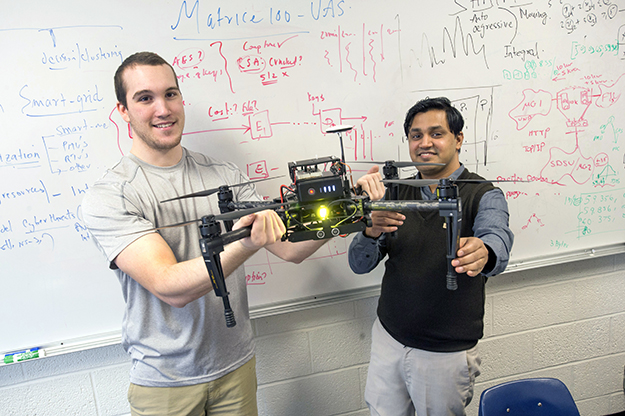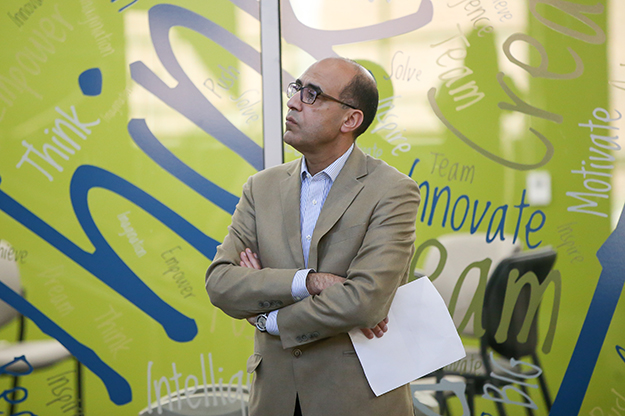Big Data, the next big thing
UND commits to computational surge to increase analytical firepower on campus and beyond

When you think of the Silicon Valley in Northern California, what readily comes to mind?
How about “Route 128” near Boston? Or the Research Triangle outside Raleigh-Durham, N.C.?
Most think of high-powered and often high-tech corporations clustered within an arm’s length of research universities, always on the cusp of the next big thing in a given field.
UND has its own grand vision to be the best it can be in areas it’s already good at. It’s based on its Grand Challenges research initiative — in biomedical science, rural health, energy & sustainability, unmanned and autonomous systems, and Big Data – and a growth mindset to diversify the state’s economy away from oil and soil.
And it all starts with Big Data.
Tuesday, during his “Wake up to UND” presentation to the Grand Forks-East Grand Forks business communities, UND President Mark Kennedy announced that UND, through its College of Engineering & Mines (CEM), is making the first of what could be a number of faculty hires to support Grand Challenges research.
The first set of hires could comprise as many as six computational scientists (three junior level and three senior level professors), all well-versed, and well-funded, in the Big Data expertise, such as analytics, machine learning, artificial intelligence and robotics.
UND is using money from one of its strategic priorities pools, made possible by its new incentive-based budgeting model, to co-invest with the CEM to fund the new hires.
“Big Data is vital to every field of study,” Kennedy said. “A lot of the professors that we would be bringing in would have this expertise to spark the education that will give our employers in the region the talent they need to succeed and flourish.”

Fledgling cluster
UND Vice President for Research & Economic Development Grant McGimpsey said the new computational scientists, who will spend most of their time on Big Data research, will directly support the needs of the other Grand Challenge focus areas on campus.
“Big Data is a very different Grand Challenge than the others,” he said. “The way I look at it is that computational research, algorithm development, data analytics all underpin the other four Grand Challenges.”
McGimpsey said the most immediate off-campus impact of the beefed up computational expertise could be on the UAS side, a field where UND is pioneering in Detect-and-Avoid and Beyond the Line of Sight technologies and the integration of drones into civilian airspace.
UND, with its premier John D. Odegard School of Aerospace Sciences, is nestled in the heart of a robust UAS ecosystem, surrounded by small startups, established heavyweights, such as Northrup Grumman, General Atomics and Harris Corp., all with strong connections to the nearby FAA UAS Test Site, Grand Forks Air Force Base and Grand Sky, a new drone business park adjacent to the air base.
McGimpsey has talked to folks, such as Tom Swoyer, president of the Grand Sky Development Co., about the need for data analysts and computational scientists to help support the fledgling UAS cluster.
“Every company that (Swoyer) talks to, and that comes in and wants to take up space there, they have a need for information,” McGimpsey said.
With more analytical fire power clustered nearby to give them what they need, private-sector innovators and firms may be more likely to stake a claim.

Nurturing campus
But it’s not just in the UAS realm.
Hesham El-Rewini, dean of the CEM, talked about a recent trip to Fargo to meet with executives of the Bobcat manufacturing company, and how the conversations were dominated by the company’s need to analyze data effectively and turn it into information they could use.
“Everybody now is trying to find ways to deal with this tremendous amount of data and how to collect it, store it and make sense out of it,” El-Rewini said.
That includes UND’s other Grand Challenges, which also would be nurtured by a computational surge on campus.
McGimpsey sees applications in everything from biomedical science and its work with complex genomes to energy studies and the exact computations it uses to coax more oil from the state’s tricky shale geology.
“What’s missing right now from all those is how to imaginatively and creatively and efficiently analyze all the data,” he said.
Symbolic setting
Kennedy, along with McGimpsey and El-Rewini, recognized this deficiency early, and have been busy shoring things up.
They created a more nimble and collaborative academic structure to allow the computational push to thrive. UND melded the departments of Electrical Engineering and Computer Sciences into the School of Electrical Engineering and Computer Science (SEECS), housed at the CEM. Next, came the hiring of Ryan Adams, from the University of North Carolina at Charlotte, to be the first director of the SEECS.
Along the way, a Big Data focus was established to provide the entire campus much needed data science support.
Even the future headquarters for the new “Big Data Hub,” at Babcock Hall, was meticulously thought out.
El-Rewini envisions Babcock, with its namesake ties to the first dean of engineering and its location at the heart of campus, to be a collaborative space for researchers from all parts of campus and beyond.
The idea is that each College would invest in their own new faculty hires to meet their individual needs and use the Big Data Hub as a collaborative space to conduct much needed high-level computational research.
“Symbolically, I am saying that — with the Big Data Hub at Babcock – engineering will be the core but it will collaborate with the entire campus … everyone can work together to make a significant contribution to UND and to the State of North Dakota – this is the next big thing.”


